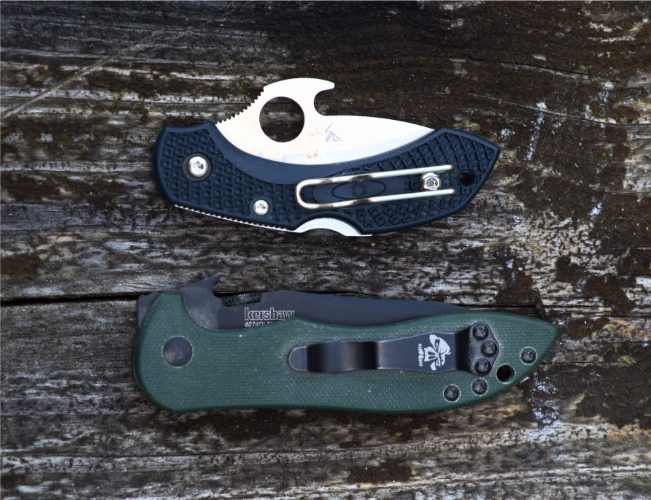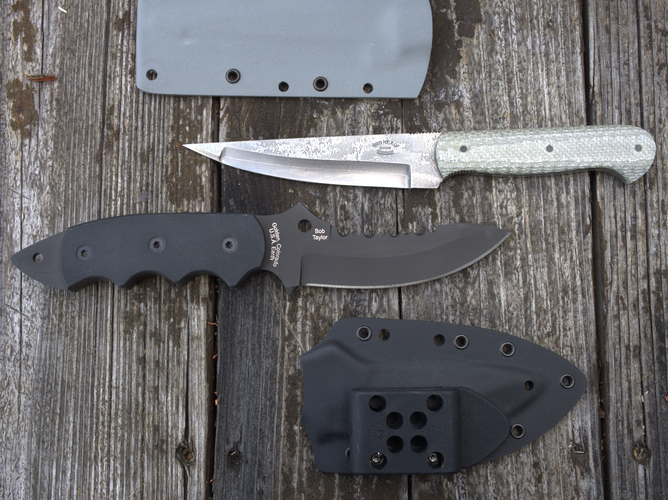THE SHARP EDGE OF READY
- Aug 12th 2025
- By
Here at PHLster, we try to acknowledge that every person is going to tailor their everyday carry gear to their personally-perceived threat environment. In a way, this is the concept around which our entire corporate ethos is built; otherwise, everyone would be walking around all the time in ballistic helmets and plate carriers, carrying carbines, and getting kicked out of Whole Foods for accidentally dragging their flash suppressor through the arugula and making everyone’s dinner salad taste like Break-Free CLP.
One of the items included in the typical list of things people include in their EDC (“Every Day Carry”, for those not hip to the TLA, or “Three-Letter Acronym”) is a knife. But when we talk about these, there are knives and then there are knives.
Personally, I’m a big fan of carrying a knife of some sort if at all possible. If you look back through the archeological record of our species, the big dividing line between “Australopithecus Somethingus” and “Homo Whateverus” is when we started carrying sharpened rocks around with us. Having to open a shrink-wrapped iPhone or a dead gazelle with your teeth versus using a sharpened tool we carried around just in case is the difference between ape-man and human.
But knives carried as general-purpose tools are different from the ones carried for personal protection.
For starters, constant use of a knife to open boxes, packages, and letters dulls the edge. That’s fine, in that it doesn’t take a scalpel to get the wrapper off the tchotchke you just bought at Wally World.
This may not seem important, but the edge of a knife intended for use as a personal defense weapon needs to be kept sharp. For the best illustration of this, the next time you’re at Texas Roadhouse or Outback or whatever your fave local chain steak joint happens to be, use a brand-new or freshly sharpened tacticool folding knife to cut your ribeye rather than the serrated butter knife they hand you rolled up in your napkin.
If you haven’t done this (and I’m sure a reasonable percentage of you probably have already), the way the sharp blade glides through the meat like the proverbial hot knife through butter. This is what you need out of a blade carried for defensive use, and why, if you plan to carry one, it needs to be a different knife than the one you use for peeling apples and opening bank statements.
These defensive implements are generally intended for a specific use, namely an unexpected entangled encounter that occurred because your attacker was skillful with their approach, you failed at reading your environment, or just dumb bad luck. The idea is to have a sharp blade that can be easily accessed with either hand and used to poke your assailant until they let go of you and allow you to open distance.
Some of the earliest varieties achieved popularity way back in the 1990s as “neck knives” which, as the name implies, were fixed-blade knives carried on cords or chains around the neck in an inverted-type sheath. With the knife hanging in the center of the chest, under the shirt, it certainly could be accessed with either the strong or weak hand. The problem was that the minute things went cattywumpus in an entangled situation, that neck knife might be anywhere under the carrier’s shirt.
This was the early days of what became the Shivworks paradigm of using an edged weapon in these sorts of situations. Because the self-defense community treats nothing as real until we’ve come up with an abbreviation or acronym for it, this became known as IFWA (pronounced “IF-wah”), for “In-Fight Weapons Access.
Basically if the defender, whether an undercover cop or a private citizen CCW handgun toter, were blindsided by a bad guy, they needed to be able to access a sharp tool to stab their assailant enough to make them let go so that our hero could then establish enough space to make a handgun relevant again without turning it into a wrestling match over the pistol.
The knives marketed to this niche fall into three basic categories.
The first type is the folder. While the easiest to conceal and most innocuous to the casual onlooker, it does have a couple of problems. The first is that if you carry it in a pocket or clipped into your waistband forward of your hips, there’s the temptation to use it as a general-purpose folding knife.
If it’s intended for defense use, you don’t want to dull the edge opening Amazon packages and mail and packages of batteries you bought at CVS, so you need to keep a second knife in a different place and not get them confused.

More importantly, a folding knife is, as several trainers have pointed out, a fixed-blade knife that is broken from the start. Even very rapid-opening knives using thumb studs, automatic buttons that deploy the blade with a spring (not legal in all states), or Spyderco’s famous “Spydie Hole”, it still requires performing some hand jive with the knife in your hand while rolling around on the ground with your attacker. Not ideal. The least bad option here is something using a device derived from the Emerson “wave” that hooks on the edge of your pocket and (hopefully) deploys the blade automatically as you pull it.
The second type, and the most common, is a small centerline fixed-blade knife carried slightly to either side of the belt buckle.

Exemplified by the original Clinch Pick from Shivworks or the little TDI knives offered by Ka-Bar, these give a compact knife with a small, sharp blade that can be carried unobtrusively on the centerline but have enough of a grip that they can be reliably accessed in a scuffle.
Finally, there are slightly larger blades. Bud Nealy offered the MCS “Multi Carry System” for his medium-sized fixed blades as far back as the Nineties. These could be carried inside the waistband, as neck knives, or inside a gent’s sports coat.

Once you are getting into four-inch and longer blades, though, you’re getting closer to dueling on a sand bar with Jim Bowie in the 19th Century than going to Kroger in the 21st. When it comes to carrying a blade, assess your real needs and choose judiciously.